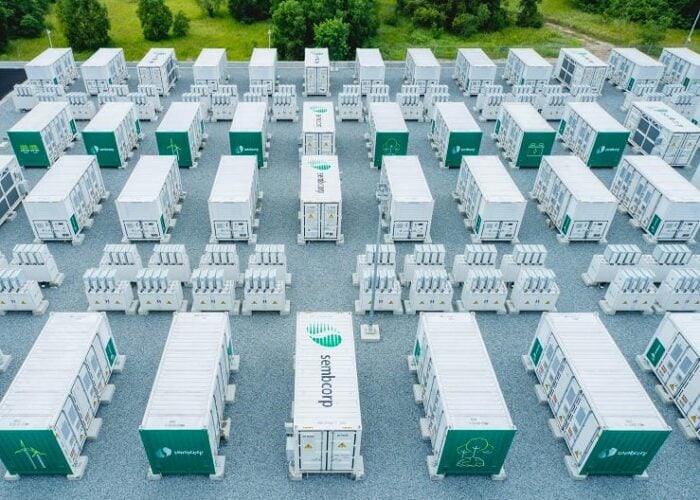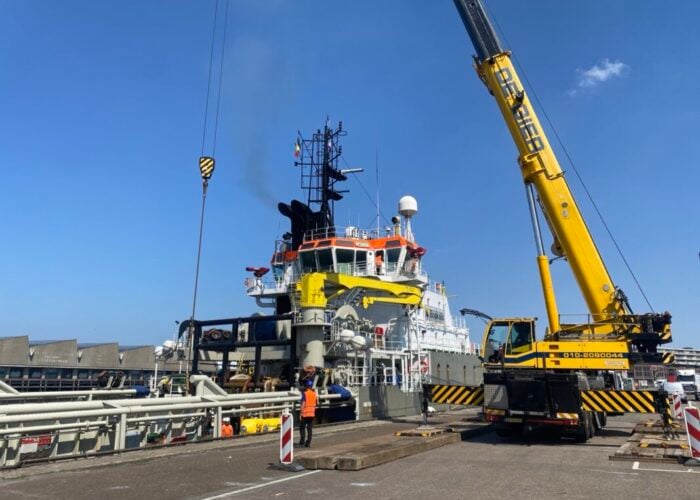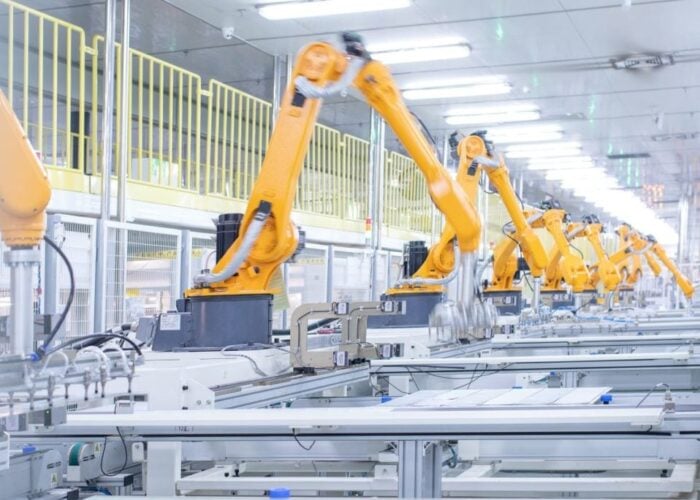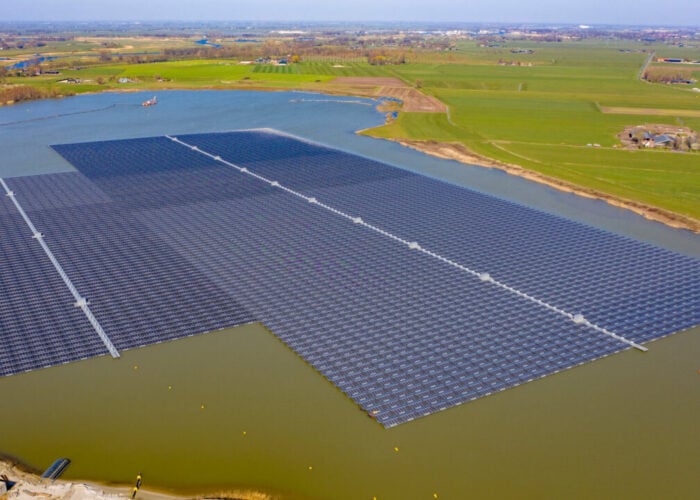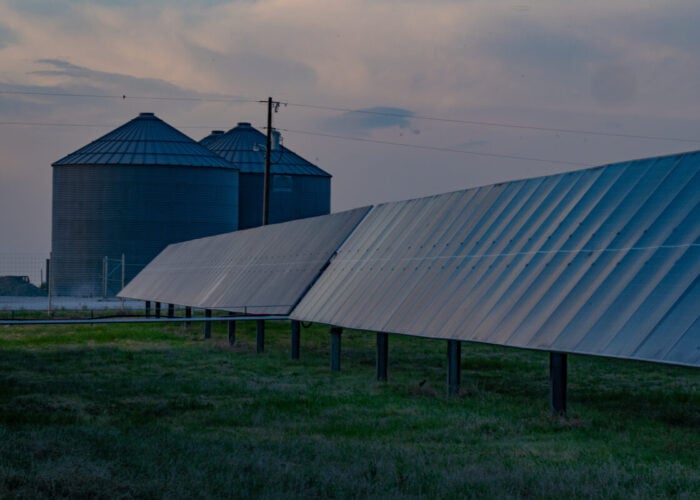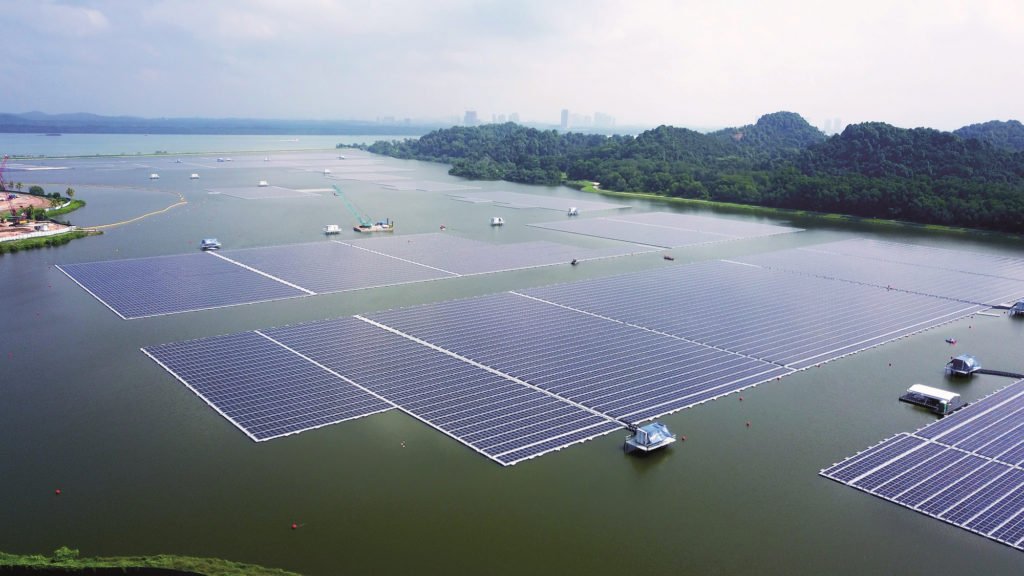
Project name: Tengeh Floating Solar Farm
Location: Singapore
Unlock unlimited access for 12 whole months of distinctive global analysis
Photovoltaics International is now included.
- Regular insight and analysis of the industry’s biggest developments
- In-depth interviews with the industry’s leading figures
- Unlimited digital access to the PV Tech Power journal catalogue
- Unlimited digital access to the Photovoltaics International journal catalogue
- Access to more than 1,000 technical papers
- Discounts on Solar Media’s portfolio of events, in-person and virtual
Capacity: 60MWp
Energisation date: July 2021
With an electricity mix currently dominated by fossil fuels and limited land availability for ground-mounted projects, Singapore is turning to floating PV (FPV) to increase its renewables capacity as it aims for 2GW of deployed solar by 2030.
The island city-state, which currently generates around 95% of electricity generation from natural gas, made significant progress earlier this year with the inauguration of its first utility-scale FPV plant.
Installed atop a reservoir and spanning 45 hectares, the 60MWp Tengeh Floating Solar Farm was built in less than a year despite COVID-19 challenges and is now able to power Singapore’s five local water treatment plants while also contributing to the national electricity grid.
The project involved a collaboration between the country’s national water agency PUB and local energy company Sembcorp Industries, as well as a host of contractors. When the plant was inaugurated in July, Sembcorp CEO Wong Kim Yin described it as “a crown jewel in our portfolio and a showcase for Singapore”.
The success of the project has since led PUB to explore the development of two more utility-scale FPV plants as it aims to benefit from the dual-purpose of its reservoirs: clean energy generation to offset its energy consumption and storage of water to drink after treatment.
One of advantages of deploying floating solar systems on reservoirs is their higher efficiency compared to ground-mount projects, primarily due to the cooler reservoir environment, says Jen Tan, head of integrated solutions (Singapore and Southeast Asia) at Sembcorp Industries, adding that solar panels in open waters do not experience shading from nearby buildings, further enhancing their ability to maximise energy generation.
“In Singapore and other major cities in Southeast Asia, floating solar is one of the key sources of renewable energy production as it will help to overcome our physical land constraints,” she says.
Key facts
- Modules: more than 122,000, primarily Trina Solar’s 210 Vertex dual-glass panels
- Site: 45 hectares
- Layout: ten floating ‘islands’
- Construction time: 11 months
Innovative construction techniques
The Tengeh reservoir, located in the west of Singapore near the border with Malaysia, was initially used to host a 1MWp floating solar testbed that was deployed in 2016 to compare FPV solutions and study the economic and technological feasibility of deploying large-scale systems. Comprising ten types of floating structures and PV modules constructed by nine different companies, the testbed was managed by the Solar Energy Research Institute of Singapore (SERIS).
“At that time not much was known yet about the impacts and benefits of floating solar,” Thomas Reindl, deputy CEO at SERIS, tells PV Tech Power. “Over the years we learned about the energy yield gains, challenges during operation, and PUB also evaluated whether there are any adverse environmental impacts.”
The results from the site were favourable and showed that FPV systems performed 5 – 15% better than a typical rooftop solar PV system in Singapore, according to PUB, which then carried out environmental and engineering studies before deciding to proceed with the utility-scale installation.
PUB launched a request for proposals in 2019 to invite private sector companies to design, build and then own and operate the large-scale facility for 25 years, with Sembcorp Floating Solar Singapore awarded the contract in early 2020.
Jen Tan says one of the main challenges in developing the plant was ensuring that materials used will be durable for at least 25 years. “As FPV is relatively new, there was no 25-year case study available. Hence, the testbed that was already built by PUB in 2016 offered very important insights,” she says. Based on studies from the test sites, Sembcorp had sufficient data that allowed it to select a system that is durable, environmentally sound and suitable for the local climate.
When construction began in August 2020, PUB and Sembcorp said each component of the system was designed and selected based on Singapore’s climate in order to maximise energy generation, including the choice of double-glass modules to enhance durability in the wet and humid environment. The plant includes more than 122,000 panels and primarily features Trina Solar’s 210mm Vertex dual-glass modules, rated at 490Wp.
Tengeh project timeline
- 2016: floating solar testbed launched at Tengeh Reservoir to study feasibility of deploying large-scale FVP systems on Singapore’s reservoirs
- June 2019: PUB launches request for proposal, inviting companies to design, build and then own and operate the project for 25 years
- July 2019: DNV appointed technical advisor to provide tender support and proposal evaluation during the bidding phase
- February 2020: Sembcorp Solar Singapore appointed to construct the project
- May 2020: PUB and Sembcorp sign 25-year power purchase agreement
- August 2020: Construction work starts
- July 2021: Project completion
The scale of the installation required significant manpower for construction, which coincided with the country entering a circuit-breaker coronavirus restriction period. To comply with government measures, Sembcorp developed a playbook to keep workers safe, segregating the site into different zones to reduce intermingling.
Innovative ways of working were needed to mitigate the impact of the pandemic on manpower resources and supply chain constraints. Sembcorp implemented a new engineering technique to design a custom-built jig that ensured a standardised process to tighten the nuts and bolts during the mounting of solar panels onto its floats – a process that the company said increased the rate module assembly by up to 50%.
Despite the challenges, the project was completed in just under a year and was the result of a collaboration between several stakeholders – engineers, contractors and consultants – that Jen Tan says joined forces to “develop cutting-edge engineering and construction techniques”. Quality assurance company DNV was originally contracted by PUB to be a technical advisor for the plant, while Sembcorp worked with partners such as Sungrow Power Supply and Shanxi Electric Power Engineering.
Additionally, a collaboration with Quantified Energy Labs, a technology spin-off from the National University of Singapore, saw advanced drone electroluminescence imaging technology deployed at the project. This technology captures X-ray-like signals emitted by modules to pinpoint potential module defects that could have been caused during the manufacturing or installation stages.
The project’s performance and reliability are now backed by a digital monitoring platform that features safety cameras, video monitoring and alerts that help to track wind speed, solar irradiation and the ambient temperature. It also detects abnormalities that may indicate potential overheating and fire hazards.
“Some floating projects lack smart surveillance on the physical health of their FPV systems, so we built and implemented smart technologies to enhance active monitoring,” says Jen Tan. GPS trackers also helped to remotely monitor and detect any misalignment in the positions of the array islands, which are tethered to the reservoir bed to prevent movement in strong winds and ensure worker safety during inspection.
Limiting environmental impacts
The main concern PUB initially had with deploying solar on reservoirs was the potential impact on surrounding environment, biodiversity and water quality, especially important given the Tengeh reservoir supplies drinking water.
The agency conducted environmental studies at Tengeh reservoir between 2015 and 2018, covering the potential impacts of the FPV system on wildlife, water quality and the microclimate. Results showed no observable change in the reservoir’s water quality and no significant effect on the surrounding wildlife.
“We were mindful of the need to ensure minimal impact on water quality and the environment, especially during the construction phase”
PUB worked with Sembcorp to put in place an Environmental Management and Mitigation Plan to minimise any impacts on the reservoir. That plan included the monitoring and management of biodiversity, water quality, sediment quality and noise pollution before, during and after construction of the project.
“As the water in the reservoir is used to store rainwater for subsequent treatment into drinking water, and reservoirs are usually populated with wildlife, we were mindful of the need to ensure minimal impact on water quality and the environment, especially during the construction phase,” says Chong Mien Ling, director of policy & planning and chief sustainability officer at PUB.
Following consultations with nature groups, it was decided to avoid the south of the reservoir so as not to encroach on the nesting area of the grey-headed fish eagle, a near-threatened species, and leave two-thirds of the reservoir’s surface untouched, allowing wildlife to continue to forage and hunt.
Another consideration was the design of the anchoring and mooring system for the solar PV arrays. “For a floating solar farm, unlike a land-based or rooftop PV farm, it was critical to design a stable and supportive floating PV array that could last for 25 years of operations,” says Chong Mien Ling. Floats were selected that are made of high-density polyethylene (HDPE) – a certified food-grade material that is recyclable and UV-resistant to prevent degradation from the intense sunlight exposure.
Gaps between the panels, which are coated with anti-reflective materials to minimise glare, are also said to allow for sufficient sunlight and airflow to enter the waters, supporting the ecosystem beneath, while aerators have been installed to maintain oxygen levels in the reservoir.
A blueprint for Singapore’s future?
The commencement of the Tengeh project’s operations marks a significant step towards enduring energy sustainability in water treatment, making Singapore one of the few countries in the world to have a 100% green waterworks system, PUB and Sembcorp said when the plant was energised.
Electricity generated from the farm is sufficient to offset about 7% of PUB’s annual energy needs. And valuable experienced gained from the Tengeh plant can be expected to support the country as it bids to reach 1.5GWp of deployed solar by 2025.
Research from SERIS published last year revealed that more Singapore has more than 4.5km2 of usable area for floating solar deployment, representing about 12% of the total area that was found usable for PV installs in the country, with the rooftop segment showing the strongest potential. The report found that only a fraction of the city-state’s water bodies can be used for FVP due to restrictions such as environmental concerns as well as competing uses such as for recreational and military training purposes.
The 4.5km2 figure includes near-shore areas, which Reindl of SERIS says represent a great opportunity for floating PV in Singapore. “Near-shore areas are also suitable for multi-purpose uses of spaces, especially through the combination of floating solar with fish farming, desalination, or green hydrogen production,” he says.
Adding to its existing fleet of rooftop solar projects at its facilities across Singapore, PUB announced in October that two FPV additional projects, each with a capacity of 1.5MWp and built above reservoirs, have started operations.
Chong Mien Ling says that in identifying suitable sites for future floating systems, PUB will take into consideration the reservoir surface area available, existing use (water and recreational activities) and potential environmental concerns. The agency is now exploring the development of two FPV plants on reservoirs that are expected to have capacities of 100MWp and 44MWp, with consultancy studies now underway.
“With solar energy being plentiful and future water demand expected to increase, we hope to harness more of this renewable resource to reduce PUB’s carbon footprint, contributing significantly to our national climate change mitigation efforts,” says Chong Mien Ling.
For Sembcorp, which announced plans earlier this year to increase its renewables capacity almost fourfold to 10GW by 2025, the company is now looking to develop more FPV projects across Southeast Asia, drawing on its experience from the Tengeh farm.
“The potential is there for the world to reach the terawatt peak range for FPV,” says Jen Tan. “With the substantial amount of learning, the Sembcorp Tengeh Floating Solar Farm provides a blueprint for the design, construction, operations and maintenance of future large-scale floating solar PV systems.”
Singapore accelerating solar deployment through whole-of-government effort
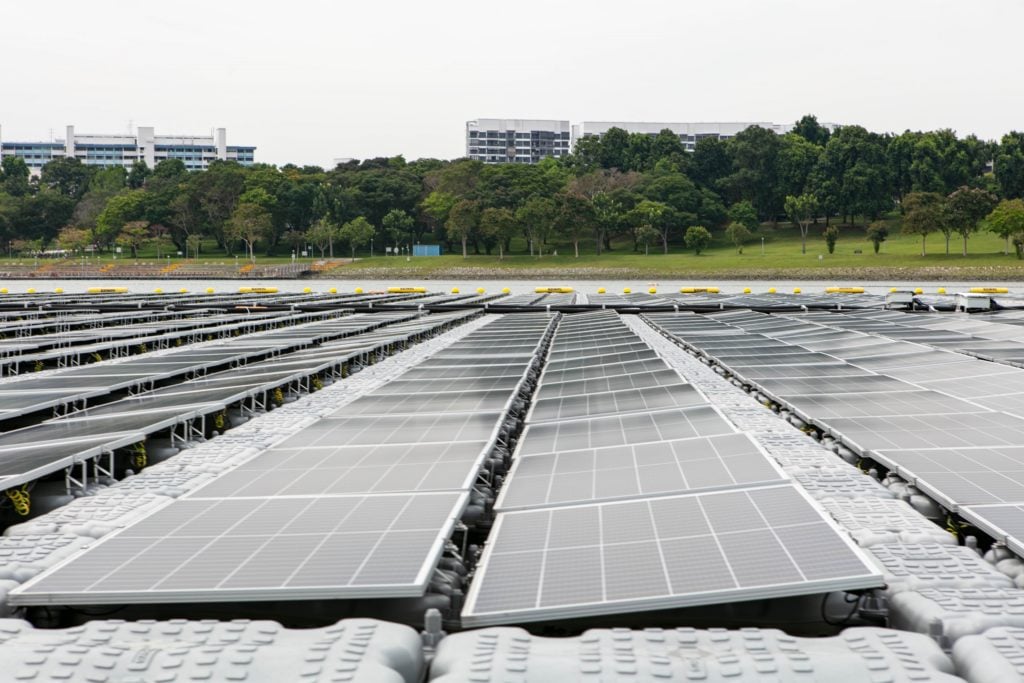
Having achieved its 2020 target of reaching 350MWp of installed solar, Singapore is aiming to make use of water bodies and rooftops to help reach a new ambition of having 1.5GW of PV deployed by 2025.
With high solar irradiance levels, Singapore’s solar sector is expected to expand and see significant investment opportunities, according to consultancy Fitch Solutions, which said in research published earlier this year that land constraints result in limited scope for large-scale solar facilities, meaning any solar growth will be in the form of floating PV (FPV) or rooftop systems.
As the government pushes for increased renewables generation, Fitch said the country’s Energy Market Authority lowered the fixed component of the license fee for generators ranging from 10MW to 400MW, reducing the cost of deploying solar, while application processes for solar installations were streamlined and simplified.
Solar is one of four ‘switches’ that Singapore is focusing on as it aims to change the way it produces and consumes energy. The other three are regional power grids, natural gas and low-carbon alternatives such as hydrogen.
“In the absence of other forms of renewables such as wind, hydro, or biomass, solar PV is the only viable renewable energy option in Singapore,” says Thomas Reindl, Deputy CEO at the Solar Energy Research Institute of Singapore, adding that there is a whole-of-government initiative to push for more PV deployment.
The country’s Housing & Development Board launched the sixth tender under its SolarNova programme earlier this year to support the deployment of 70MWp of solar systems at apartment blocks and 57 government sites.
Another initiative from government agency JTC Corporation called SolarLand is focused on deploying PV systems on vacant plots of land. Energy company Shell signed an agreement earlier this year to explore the development of a solar project with a capacity of at least 72MWp at a landfill site as part of that programme.
Finally, national water agency PUB is supporting FPV deployment on the city-state’s reservoirs. “Solar energy is the most viable form of renewable energy for Singapore,” says Chong Mien Ling, director of policy & planning and chief sustainability officer at PUB. “Our reservoirs, with large water surfaces, have good potential to harness solar power in land-scarce Singapore.”
Reindl says all three programmes are competitive (through public tenders) and “receive strong resonance in the market”.


